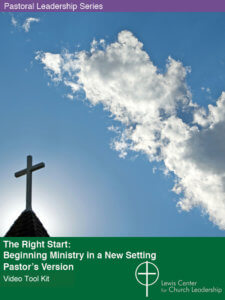Starting a new ministry is both exciting and challenging. As you enter a fresh ministry context, you’ll encounter unique dynamics within your congregation, whether you’re breaking new ground as the first woman or person of color or joining a congregation facing its struggles. Andreá Cummings provides steps to take within the first ninety days to help you build relationships and trust with your congregation, identify areas needing improvement, learn about your community, and forge new relationships with key stakeholders.
As you enter a fresh ministry context, these steps will assist you in birthing new ministries, developing a vision and mission, and ultimately making new disciples of Jesus Christ.
1. Set a goal to meet with 60% of your congregation that attends worship regularly.
This may seem like a lofty goal, but it’s achievable. I did not meet with my congregation during my first appointment, and if I had, many of the challenges we faced could have been handled more smoothly. Now, in my third appointment, I understand the advantages of setting a goal to meet with at least half of the congregation within the first 90 days.
2. Commit to offering times to meet with new members.
Depending on your church’s size, you can approach this goal in various ways.
- Coordinate with your ministry leaders or administrative assistant to schedule the meetings that work with people’s schedules and make the sign-ups easily accessible. You can refer to the meet-up as meet-and-greets, porch visits, or another name that clearly indicates the purpose of the gathering.
- Offer availability to meet with members outside of the group meetings. Ensure you have a method for people to sign up. Additionally, make sure to announce this during worship and share it through all your communication channels.
3. Go to the people and limit the number of participants for each gathering.
Meeting in homes or smaller spaces invites an environment that is welcoming and intimate. To ensure everyone has a chance to be heard, ask leaders to host you and no more than 15 people at each gathering. The host home can provide refreshments or opt for a shared meal. I have served in a church with 1,500 members, and these small gatherings are still possible.
4. Create questions that will help you get to know your members and the ethos of the congregation.
Ask the same questions each time!
- What is your name? What do you do? What is one fun fact about you?
- What do you love most about our church?
- What, if anything, would you like to change about your church?
- What is the vision/mission of our church?
- What challenges do you think our church faces?
- What are your hopes for the church in the next few years?
As you ask these questions, let everyone know that your goal is to listen. Ensure that everyone knows they will be heard. It is best if you can write their responses in a dedicated notebook. You can record their responses and have the notes transcribed or have a dedicated notetaker. For members who cannot meet in person, you can create a survey with the same questions and send it via email. Google or Microsoft Forms are good options. What should you do with the information after you have met with your congregation?
5. Evaluate feedback from congregation meetings.
- What themes emerge from your congregation’s feedback?
- Are there any conflicts?
- If the church has vision and mission statements, are most members familiar with them?
- What challenges arise repeatedly?
- Do members express affection for their church, and if so, what are the top three reasons?
There’s still more to do …
6. Learn about the community within a 2.5-mile radius of your church.
MissionInsite is a valuable tool designed for churches, faith-based organizations, and nonprofits that assists pastors and laity in unlocking the potential of their new communities. By providing comprehensive demographic insights and local trends, it empowers leaders to understand the unique needs and desires of their neighbors. This invaluable resource equips pastors to create impactful ministries and foster vital connections with new people in the community. Additionally, the United States Census Data serves as a helpful resource for churches with limited budgets.
7. Meet with local organizations, board members, elected officials, and school counselors.
- What gaps exist in addressing the needs of the community that our church can help fill?
- How can our involvement in a committee enhance your understanding of the community?
Learning about your community allows you to gain the knowledge necessary to identify its needs, enabling the creation of new ministries. It also helps your new church view its community from a fresh perspective. Many congregations have been part of their communities yet remain unaware of them. Numerous congregations find themselves disconnected from their communities. Many congregations require new insights to forge new beginnings in connecting with new people and developing ministries that spread the love of Christ.
Now it’s time to share the exciting new possibilities!
8. Share the information with ministry leaders.
Meet with ministry leaders to share your findings and use these themes to develop ministry goals, vision, or mission statements. You can either share this information with your key ministry leaders and clergy during a mini-retreat or a regular meeting.
9. Share the exciting goals, mission, and vision with your congregation.
Share the goals and visions with your congregation. You can do this via a letter or newsletter, a town hall, a video on social media, a podcast, or a sermon series. When sharing the feedback from the congregation, do not include the names of members. You should include the number of members who provided feedback.
Make sure that in whatever format you choose to share the findings of your three-month listening sessions and digging into learning about your community, you do so with excitement about the future! Encourage the congregation to engage with the Holy Spirit, to dream together, create new ministries, make new disciples, and grow in faith.
 Related Resources
Related Resources
- The Right Start: Beginning Ministry in a New Setting, a Lewis Center video tool kit resource
- 50 Ways to Improve Pastoral Transitions, a free Lewis Center resource
- 5 Stewardship Priorities for Incoming Pastors by Lovett Weems and Ann Michel
- 4 Traps for Clergy When Moving to a New Congregation by Bill Wilson
If you would like to share this article in your newsletter or other publication, please review our reprint guidelines.






